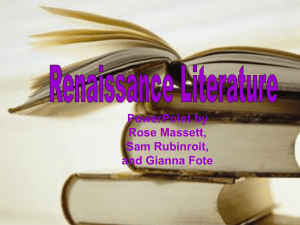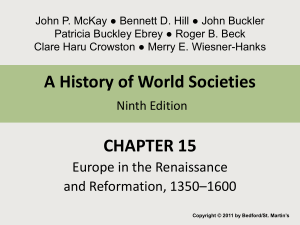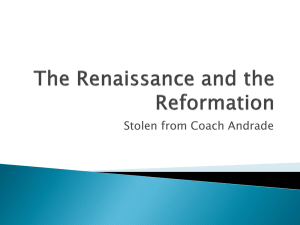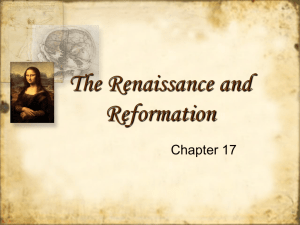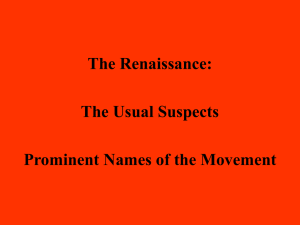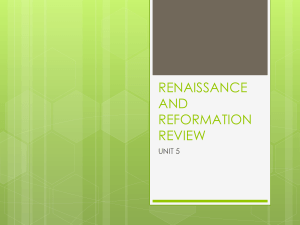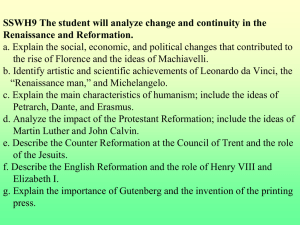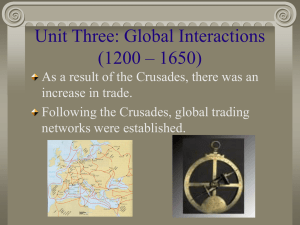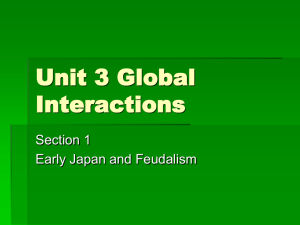1.1 Renaissance and Exploration
advertisement
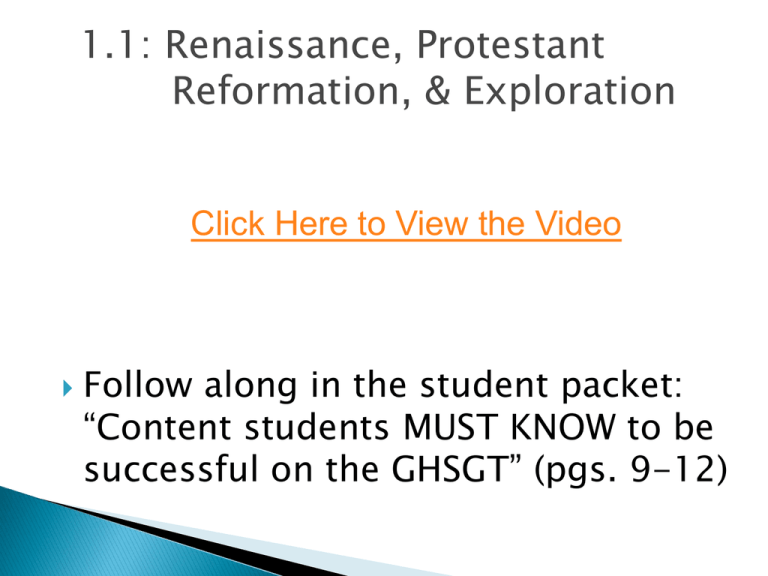
1.1: Renaissance, Protestant Reformation, & Exploration Click Here to View the Video Follow along in the student packet: “Content students MUST KNOW to be successful on the GHSGT” (pgs. 9-12) The student will analyze change and continuity in the Renaissance and Reformation. What is the Renaissance? During the Renaissance (1300 to 1600), Western Europe emerged from the Middle Ages: Renaissance means “rebirth” Revival in Greek & Roman ideas New ideas in art, government, & human potential; Trade; Cities The Renaissance marked the beginning of the “modern era” Indicator A Explain the social, economic, and political changes that contributed to the rise of Florence and the ideas of Machiavelli. RENAISSANCE WRITERS Renaissance humanists were challenged “traditional” beliefs, wrote in the vernacular, & took advantage of the printing press: Erasmus Petrarch Dante Machiavelli Introduction Can you identify the following Teenage Mutant Ninja Turtles? Donatello Michelangelo Leonardo Rafael Introduction Not bad! But it’s doubtful whether that question will be on the GHSGT or knowledge of these guys will have any lasting significance. Indicator B Identify artistic and scientific achievements of Leonardo da Vinci, the “Renaissance man,” and Michelangelo. Classical Ideas Religion Perspective The Individual Realism Leonardo da Vinci Viewed as the original “Renaissance _ man” for his expertise in painting, sculpting, engineering, physics, anatomy and other subjects. His most well known paintings are the Mona Lisa and The Last Supper. He produced mechanical drawings so detailed that they could be used as technical plans for construction. He conceptualized many inventions that were not realized until the 20th century. “The Last Supper” by Leonardo da Vinci Leonardo da Vinci’s “Mona Lisa” Leonardo da Vinci “Renaissance Man” Leonardo da Vinci - Inventions Leonardo da Vinci - Inventions Leonardo da Vinci - Inventions Michelangelo Indicator C Explain the main characteristics of humanism; include the ideas of Petrarch, Dante, and Erasmus. Humanists Studied the history, philosophy, and poetry of the ancient ______ Greeks and Romans. They challenged “traditional” beliefs, wrote in the vernacular, & took advantage of the printing _______. press : Machiavelli Petrarch Dante Erasmus Petrarch Often called the “______” father of Humanism He argued that no conflict existed between secular achievements and a person’s relationship with _____. God He believed God had given people intelligence and _______ talents that should be used to the fullest in all aspects of life. Dante Took the humanist ideas of his contemporaries and incorporated them into literature written in the common language (vernacular) of his day. __________ Most serious writers of the Renaissance wrote exclusively in ______. Latin He is considered to be the father of the _______ Italian language because he wrote his books using the common language of Florence. Erasmus A Dutch Christian Humanist who believed in reforming the Catholic Church from ________. within He believed in free _____ will rather than the predestination of the Protestant movement. All of the following are true about the Renaissance EXCEPT Fr ... a. .. 5% in eg an It b Ne w id ea s in G re ... n e. .. Re vi va li 4. 5% 0% m 3. ss an ce 2. 90% Renaissance means “rebirth” Revival in Greek and Roman ideals New ideas in art, government, human potential It began in France. Re na i 1. 10 In his work, The Prince, he described the combination of force and shrewd decision-making required by a ruling prince to maintain power and order. 23% 14% Er as m us 0% Da nt e 4. ar ch 3. Pe tr 2. Machiavelli Petrarch Dante Erasmus M ac hi av el li 1. 64% 10 All of the following are works of Michelangelo EXCEPT ce ... on 15% Pi et a 10% Li sa 4. 20% Pa in tin g 3. M on a 2. David Mona Lisa Painting on ceiling of Sistine Chapel Pieta Da vi d 1. 55% 10 He is considered by many to be the father of the Italian language because he wrote his books using the common language of Florence. Er as m 0% us 4% Da nt e 4. 30% ar ch 3. Pe tr 2. Machiavelli Petrarch Dante Erasmus M ac hi av el li 1. 65% 10 He was a Dutch Christian Humanist who believed in reforming the Catholic Church from within the institution. 95% us 0% Er as m 5% 0% Da nt e 4. ar ch 3. Pe tr 2. Machiavelli Petrarch Dante Erasmus M ac hi av el li 1. 10 He argued that no conflict existed between secular achievements and a person’s relationship with God. 5% us 5% Er as m 9% Da nt e 4. ar ch 3. Pe tr 2. Machiavelli Petrarch Dante Erasmus M ac hi av el li 1. 82% 10 Indicator D Analyze the impact of the Protestant Reformation; include the ideas of Martin Luther and John Calvin. The Protestant Reformation Click Here How did his criticisms expand into an effort to form a new church? • Wrote ___ 95 Theses to start debate on Church abuses • Published books and pamphlets ____________ questioning Church teachings • Ideas for reform led to breaking with the Catholic Church and formed Lutheranism as the first __________ Protestant Church. 1. congregations choose their own __________ ministers 2. worship of saints and holy days “_______” sinful 3. mass conducted in ___________ instead of Latin German 4. clergy allowed to _________ marry Calvinists (1546) • Founded by John ________ Calvin • Believed in predestination (God had predetermined who would obtain __________) salvation • Thought a disciplined, strict life would prove who had been _________ chosen • Believed in theocracy - government ruled by the ________ Church where behaviors such as dancing, drinking alcohol, and gambling would be outlawed. Indicator E Describe the Counter Reformation at the Council of Trent and the role of the Jesuits. The Catholic Reformation Click Here Protestant Reformation Indicator F Describe the English Reformation and the role of Henry VIII and Elizabeth I. Conflict Anglicans (1534) • Founded by King Henry ______ VIII of England • King Henry enraged by pope’s decision not to grant him _________ divorce • Believed the monarch, not the ______, pope was supreme religious authority of England • Broke away, but beliefs were almost the same as the ________ Catholic Church • When his daughter, Elizabeth, became Queen, she turned the Anglican church to a moderate form of _____________. Protestantism Indicator G Explain the importance of Gutenberg and the invention of the printing press. Human Potential Martin Luther believed 1. 2. 3. 4. Salvation could be attained through good works. Johann Tetzel was a great man. God predestined those who would be saved. Salvation was by faith alone. 10 Martin Luther did all of the following EXCEPT 5 an d. .. bo ok s he d th e ed Pu bl is th e sa le An gl ic an ... o. .. .. s Th es i ne d Fo rm 0 95 4. 0% 0% 0% 0% Co nd em 3. hi s 2. Na ile d Nailed his 95 Thesis on the door of a Catholic church Condemned the sale of indulgences Formed the Anglican Church Published books and pamphlets questioning Church teachings 1. 10 What expanded the circulation of literary works during the Renaissance? 1. 2. 3. 4. Improved advertising The printing press Unity in Europe The support of the church 10 This person printed the first Bible in Europe made with moveable type. This invention allowed the ideas of the Protestant Reformation to spread rapidly. 5 Queen Elizabeth I King Henry VIII John Calvin Martin Luther Johann Gutenberg .. ut en be . G Lu th er in Jo ha nn M ar t He nr y Ki ng 0 Q ue en El iz ab et ... 5. Ca lv in 4. .. 3. Jo hn 2. 20% 20% 20% 20% 20% VI I. 1. 10 ef or Co m a. un .. te rR Th ef e or Pr m ot a. es .. ta nt R ef or ... Th e Re na is sa nc e 0% R Th e Ca th ol ic 0 Th e 5 Name of the movement against corrupt practices within the Catholic Church 1. The Catholic Reformation 2. The Counter Speed! Reformation 3. The Protestant Reformation 0% 0% 0% 4. The Renaissance 10 Lutherans Jesuits Calvinist Anglicans 0% 0 0% 0% 0% An gl ic an s 4. Ca lv in is t 3. ts 2. Je su i 1. Lu th er an s 5 A group of Catholics who believed in restoring Catholicism to newly Protestant areas of Europe. 10 The Diet of Worms The Inquisition The 95-Theses The Council of Trent f.. . Co un ci lo Th e Th e 0 Di et of W o. .. 4. 95 -T he se s 3. Speed! Th e 2. 25% 25% 25% 25% In qu is i ti o. .. 1. Th e 5 A body of Catholic Bishops who met over a period of 18 years to work on reforming corrupt practices within the Catholic Church 10 The student will analyze the impact of the age of discovery and expansion into the Americas, Africa, and Asia. Indicator A Explain the roles of explorers and conquistadors; include Vasco da Gama, Christopher Columbus, Ferdinand Magellan, and Samuel de Champlain. Indicator B Define the Columbian Exchange and its global economic and cultural impact. Indicator C Explain the role of improved technology in European exploration; include the astrolabe. The Age of Exploration Click Here The Age of Exploration The Netherlands created the England created 13 colonies in North America Dutch East India Company & began st (Jamestown, Virginia was 1 in 1607) that will to dominate trade in the East Indies eventually become the United States The Dutch colonized Manhattan in New York France unsuccessfully explored New World looking for a northwest passage to Asia; Colonized Canada & established a fur trade The Columbian Exchange The first European to lead an expedition that successfully circumnavigated the earth. 1. 2. 3. 4. Vasco Da Gama Christopher Columbus Ferdinand Magellan Samuel de Champlain 10 This person’s voyages to Eastern Africa and Western India helped Portugal establish key positions along the Indian Ocean. 1. 2. 3. 4. Vasco Da Gama Christopher Columbus Ferdinand Magellan Samuel de Champlain 10 This person helped establish a permanent European settlement on the island of Hispaniola and facilitated contact between Europe and the people of what would become the Americas. 1. 2. 3. 4. Vasco Da Gama Christopher Columbus Ferdinand Magellan Samuel de Champlain 10 This person established the first French Colony in what would become North America in Quebec City. 1. 2. 3. 4. Vasco Da Gama Christopher Columbus Ferdinand Magellan Samuel de Champlain Speed! 10 All of the following is true about mercantilism EXCEPT 1. 2. 3. 4. Based on desire of countries to attain gold. Countries need colonies. Colonies manufacture raw materials. Colonies buy goods from mother country. 10 Items sent East across the Atlantic as part of the Colombian Exchange include all of the following EXCEPT 1. 2. 3. 4. Bananas Turkey Peanuts Potatoes 10 The Scientific Revolution Click Here This man was able to prove Copernicus’s theory of a heliocentric solar system. 1. 2. 3. 4. Copernicus Galileo Galilei Johannes Kepler Sir Isaac Newton 10 This man is famous for his laws of gravity and motion which explained many aspects of the physical world. 1. 2. 3. 4. Copernicus Galileo Galilei Johannes Kepler Sir Isaac Newton 10

